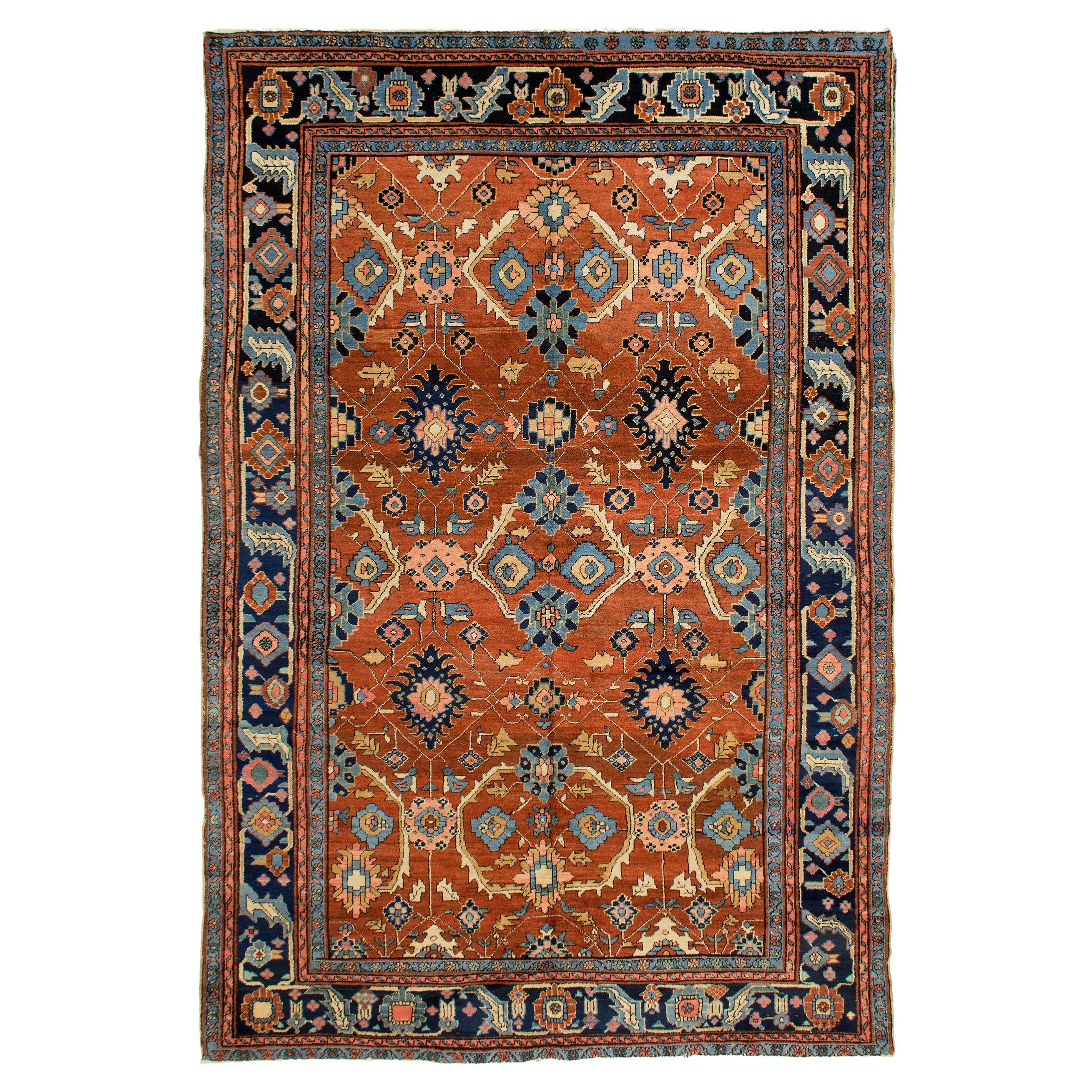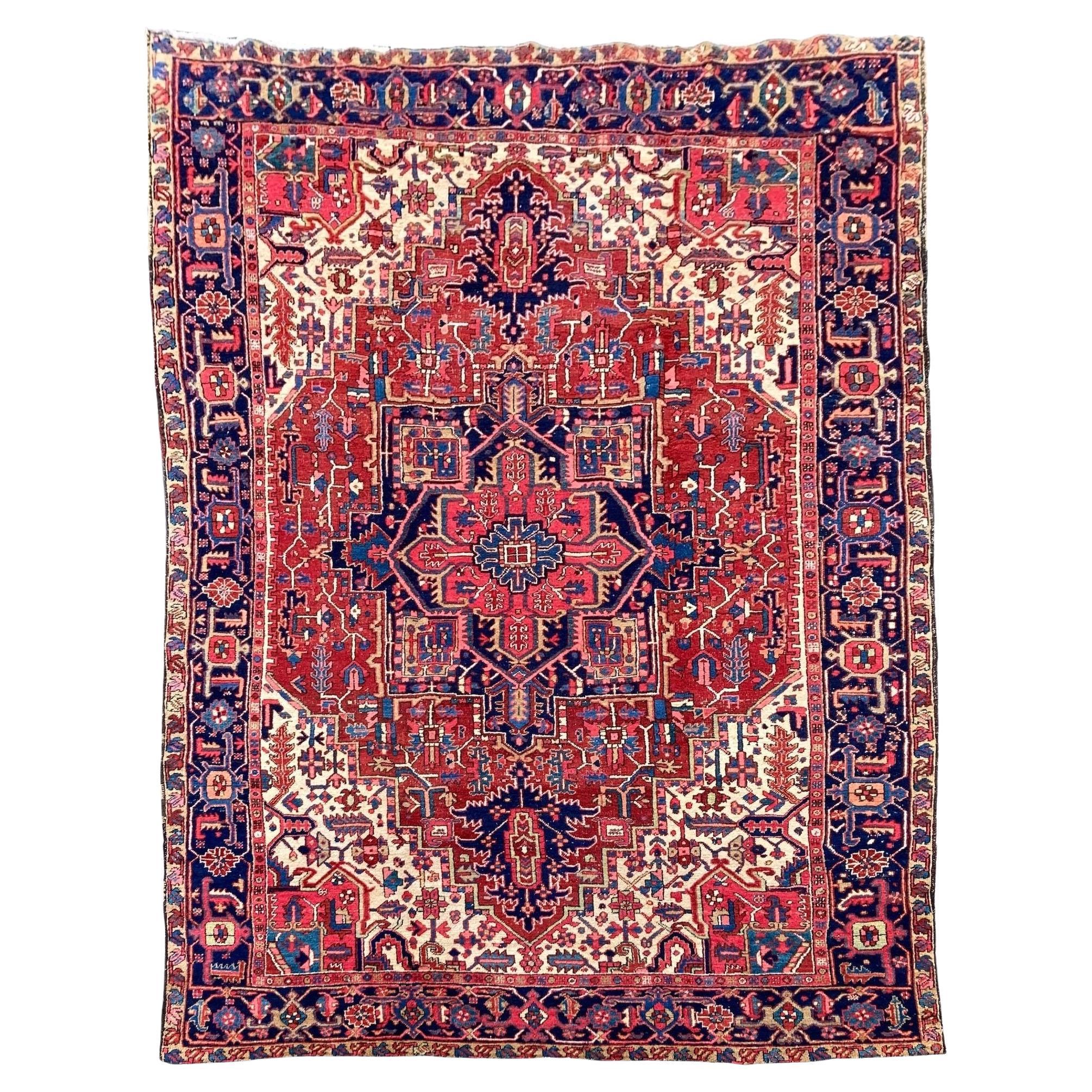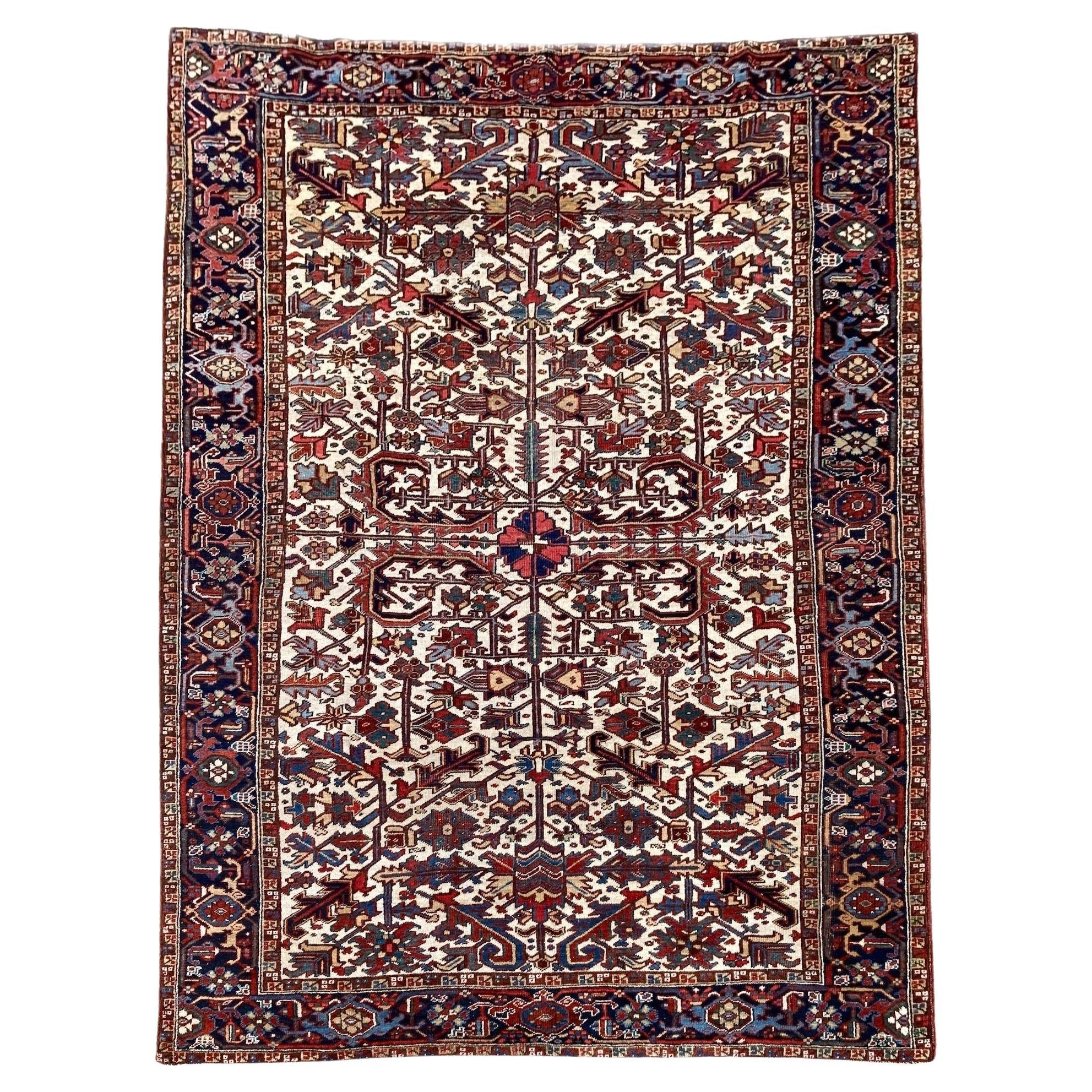Items Similar to Antique Heriz Carpet
Want more images or videos?
Request additional images or videos from the seller
Antique Heriz Carpet
About the Item
Heriz – Northwest Persia
Faithful to the traditional style of ancient Heriz Persian rugs, this masterpiece combines bold colours and designs that produce effects of straight and angular movements. The diagonal lines and rigid strokes arranged throughout the area of the rug convey a sense of movement, but not a very fluid or delicate movement. The result is a design that aims to optimize the arrangement of shapes and the connection between the various sections of the rug. The borders in accentuated colours lead the eyes to the centre of this ancient Heriz, where the medallion dominates the central area, acting as a focal point and means of connection between the networks of traces that navigate throughout the carpet. The carpet is clean and ready for use.
The ancient Heriz are probably the most popular rugs from this Persian region, with distinctive large-scale motifs and a broad palette of warm colours. In constant and growing demand over the last few decades, they have become scarce and have increased significantly in value and admiration.
These ancient Persian rugs are named after the largest city in a district with more than 30 villages in the mountainous area of northwest Persia, 80 km east of Tabriz. The population is of Azeri origin and speaks Turkic languages.
The creation of the classic Heriz “diamond square” medallion probably took place in the third part of the 19th century. The weavers of Heriz are credited with being the first in Persia to produce large-sized carpets with nomadic designs. It is believed that enterprising merchants from Tabriz, wanting room-sized Persian rugs for export, showed local weavers the city’s fine rugs and asked them to weave large rugs. The artists of Heriz, skilled in the most spontaneous and angular weaving of tribal origin, adapted these designs from ancient rugs. The result is a wonderfully captivating hybrid, a rustic and charming rug from the villages but with the richness and grandeur of the Persian court.
Heriz carpets are known to be durable floor coverings. They have a cotton foundation and wool pile. Heriz weavers also made rugs with a silk foundation and silk pile. The symmetric knot is always employed.
The virtues of the antique Heriz rugs can be found in their design and colour. The identity of a Heriz is its large medallion with large corners filled with angular oak leaves and a bold and captivating design. Some designs can be traced back to Anatolia motifs of the 17th century. The famous antique Serapi rugs from the same district tend to be more spacious, while Heriz rugs are more densely designed. The designs include large stylized palmettes, leaves, and vines, with nomadic motifs and ornaments. Some carpets have an allover layout, and others are woven with poetry inscriptions throughout the borders. Other rarely seen shapes include designs of flowers or leaves and, occasionally, the “Tree of Life” motif reminiscent of some ancient Caucasian rugs.
Indeed, the ancient carpet makers of Heriz were consummate masters of vegetable dyeing. While Heriz rugs from the last 20-40 years are often chemically dyed, at best using natural and chemical dyes, antique Heriz rugs were made with pure vegetable dyes. When they mature, they reach a wonderful patina. The technique of abrash, an intentional variation within a colour tone, is used masterfully in the best antique rugs from Heriz. The well-developed double or even triple delineation technique distinguishes the best antique rugs from Heriz and creates remarkable strength and depth of colour and design.
The best rugs in Heriz have the lustrous wool of the Shahsavan, nomads who reside near the Elbrus Mountains. Later, the wool started to be imported from Tabriz. The wool was always of the highest quality and with a high content of lanolin. The Heriz have a thick and resistant cotton base with well-compacted knots, making their durability well-known.
Many surrounding villages adopted the popular designs of Heriz in the last quarter of the 19th century. Generally, the weavings of these villages are grouped as Heriz carpets in the market, but each village is known individually by its name. The most popular villages are Ahar, Bilverdi, Sinsarai, and Bakhshaish. Although their designs were very similar to Heriz's, they all have their own characteristics, easily identifiable by their motifs, colour, and quality.
In-home design, Heriz rugs are loved for their versatility. Their geometry complements modern furniture, and their warm colours and artistic depth enhance antiques of all kinds. Their rich colour and design make them a popular choice for corporate environments. Due to their artistic uniqueness and appeal, Heriz Persian rugs are an excellent investment.
- Dimensions:Width: 98.43 in (250 cm)Length: 122.05 in (310 cm)
- Materials and Techniques:Wool,Hand-Knotted
- Place of Origin:
- Period:
- Date of Manufacture:Circa 1900
- Condition:Repaired: Professionally repaired.
- Seller Location:Barueri, SP, BR
- Reference Number:1stDibs: LU9788239477852
About the Seller
New to 1stDibs
Joined in the past six months.
No Reviews Yet
Vetted Seller
These experienced sellers undergo a comprehensive evaluation by our team of in-house experts.
1stDibs seller since 2024
- ShippingRetrieving quote...Ships From: Barueri, SP, Brazil
- Return PolicyA return for this item may be initiated within 7 days of delivery.
More From This SellerView All
- Antique Kerman CarpetLocated in Barueri, SP, BRKerman – South of Persia This rare and unique rug exhibits a design influenced by Indian aesthetics. The carpet comprises six arches between bordeaux and dark cyan colours, supporte...Category
Early 20th Century Persian Persian Rugs
MaterialsWool
- Antique Persian Kerman CarpetLocated in Barueri, SP, BRKerman – South Persia This luxurious medallion Kerman is made with flowers and vines in the centre of the navy-blue field of the rug. The highlight is the abrash technique used with...Category
Early 20th Century Persian Persian Rugs
MaterialsWool
- Antique Persian Tabriz CarpetLocated in Barueri, SP, BRTabriz – Northwest Persia This is a Tabriz rug inspired by the master of arts Hadji Jallili. Its design emphasizes subtle gradations of colour hue and precise, detailed work. Rather than the predominant medallion most commonly seen in Persian rugs, this magnificent rug displays a concentric series of extremely subtle hexagonal medallions with gently rounded borders. A finely woven geometric pattern called Herati (diamond and leaf pattern) forms the medallions, spreads across the field and continues to the corners of the carpet, adding to the atmosphere of quiet and understated splendour. An elegant rug that chooses those who want to reveal its subtle beauty. The carpet is clean and ready for use. Tabriz, a city located in northwestern Persia, is considered the city of masters of textile art. The ateliers in this influential city established a strong reputation for the quality of their carpets, which is still respected. The city of Tabriz’s fame as a carpet production centre began during the Safavid dynasty (1501 to 1722 AD). However, historical accounts indicate that carpets had been produced there since the Sasanian era (224 to 651 AD). Carpets from the Safavid period represent the pinnacle of Persian textile art, and Tabriz carpets continue this tradition. Shah Abbas (1587–1629), the great patron of the arts, established weaving centres throughout Persia, including a royal workshop in Tabriz. Some of the best Tabriz rugs, woven exclusively for carpet aficionados of the nobility, use techniques that have not yet been surpassed. After the dynasty's fall, carpet-making declined in quality and intensity throughout Persia. However, a renewed interest in 19th-century carpets revived this art, and Tabriz became an important production centre. Antique Tabriz carpets, produced in the late 19th and early 20th centuries, are distinguished by their excellent weaving technique and remarkable adherence to classical traditions and ancient Persian carpet designs. However, unlike other Persian rugs, they cannot be distinguished by any particular design pattern or use of colours. Antique Tabriz rugs come in various classic designs and are produced in every colour imaginable, from bold, bright tones to softer pastel tones. What sets them apart from other Persian rugs is their quality. Tabriz rugs are precisely designed and carefully executed, making them extremely popular with designers. A Tabriz rug adds elegance to any room in a home or office. Tabriz are known for their unsurpassed quality, strong weave and rich detail. For centuries, Tabriz carpets have been made with the highest quality since Tabriz was established as one of the first capitals of the carpet world. The artists of Tabriz boast of being the oldest in terms of production in all of Persia. Tabriz Persian carpets and their beauty not only depend on their rich cultural background but their limitless design is not surpassed by any other region. With an unsurpassed variety of colours, the Tabriz rug can be found in any tone, including bolder or softer pastel tones. Nothing beats antique...Category
Vintage 1930s Persian Persian Rugs
MaterialsWool
- Antique Isfahan Garden Paradise CarpetLocated in Barueri, SP, BRIsfahan – Central Persia Dexterously woven with a painter’s use of exquisite colour, each blossom, leaf, and bough of this lush Isfahan exhibits a distinctive jewel-like clarity and...Category
Early 20th Century Persian Persian Rugs
MaterialsWool
- Antique Kerman Carpet Palatial SizeLocated in Barueri, SP, BRKerman – South Persia A magnificent Kerman rug with a paradise design of palatial proportions. It features infinite birds and animals among a profusion of trees, flowering plants, a...Category
Mid-20th Century Persian Persian Rugs
MaterialsWool
- 19th Century Antique Persian Serapi CarpetLocated in Barueri, SP, BRSerapi – Northwest Persia This antique Serapi of high artistic calibre features vibrant colours around the large central medallion in blue and salmon on a red background. Every rug ...Category
Antique Late 19th Century Persian Persian Rugs
MaterialsWool
You May Also Like
- Antique Heriz CarpetLocated in Closter, NJHeriz is a town in northwest Persia (Iran) that has been producing carpets since the 19th century. It is located on Mt. Sabalan, a major source of copper, whose summit is 15,784 feet...Category
Early 20th Century Persian Bakshaish Persian Rugs
MaterialsWool, Cotton
- Antique Heriz CarpetLocated in Closter, NJHeriz is a town in northwest Persia (Iran) that has been producing carpets since the 19th century. It is located on Mt. Sabalan, a major source of copper, whose summit is 15,784 feet...Category
Early 20th Century Persian Bakshaish Persian Rugs
MaterialsWool, Cotton
- Antique Heriz CarpetLocated in Closter, NJHeriz is a town in northwest Persia (Iran) that has been producing carpets since the 19th century. It is located on Mt. Sabalan, a major source of copper, whose summit is 15,784 feet...Category
Vintage 1930s Persian Heriz Serapi Persian Rugs
MaterialsWool, Cotton
- Antique Heriz CarpetLocated in Closter, NJHeriz is a town in northwest Persia (Iran) that has been producing carpets since the 19th century. It is located on Mt. Sabalan, a major source of copper, whose summit is 15,784 feet...Category
Early 20th Century Persian Heriz Serapi Persian Rugs
MaterialsWool, Cotton
- Antique Heriz CarpetLocated in St. Albans, GBA beautiful antique Heriz carpet, handwoven circa 1920 with a large geometrical medallion on a terracotta field and deep indigo border. Fabulous ...Category
Vintage 1920s Persian Rugs
MaterialsWool
- Antique Heriz CarpetLocated in St. Albans, GBA beautiful antique Heriz carpet, hand woven circa 1910 with an all over geometrical design on an unusual ivory field and deep indigo border. Fab...Category
Vintage 1910s Persian Rugs
MaterialsWool





